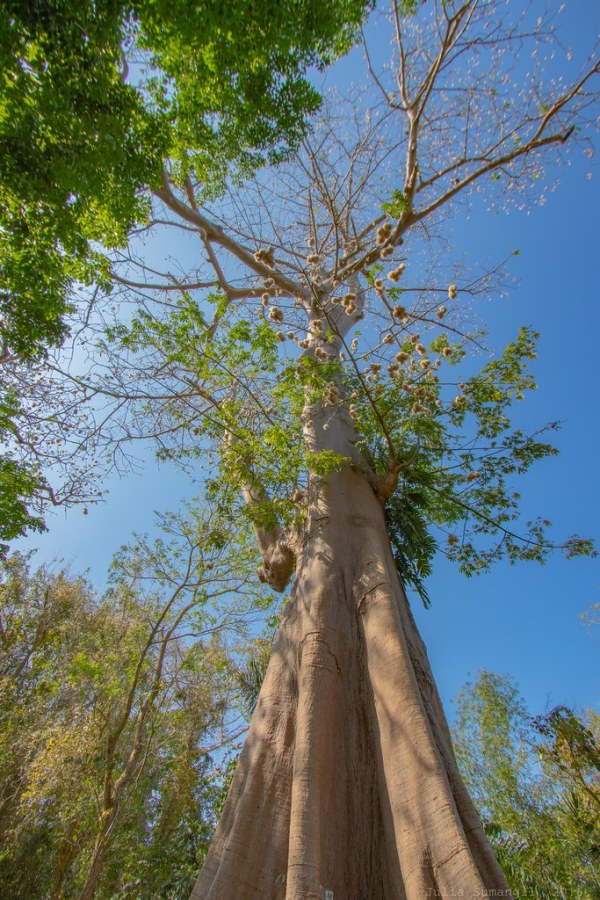Kapok (Ceiba pentandra (L.) Gaertn.) is a large deciduous tree, best known for the fibre produced by its fruit. It usually reaches a height of about 30-40 m but some varieties such as caribaea can reach 70 m (Ecocrop, 2011; Ecoport, 2011). Kapok has a broad straight trunk and almost horizontally spreading branches. Trunk and branches are supported by prickly buttresses at the base (Ecoport, 2011; Orwa et al., 2009). Some varieties are covered with rounded spines (Ecocrop, 2011). The leaves are compound (5 to 8 leaflets) (Orwa et al., 2009). Kapok produces large quantities of clustered flowers, yellowish white to rose, silky and densely hairy on the outer surface (Ecoport, 2011; Orwa et al., 2009). The fruit is a long (10-30 cm) capsule hanging from branches and contains 120-175 rounded dark brown to black seeds embedded in a mass of grey woolly hairs (floss) (Orwa et al., 2009). Kapok is a fast growing tree and becomes productive within 4 to 5 years. Yields increase for about 8 years and its economical lifespan is about 60 years (Ecocrop, 2011). A tree under optimal conditions may yield 330-400 fruits per year, giving 15-18 kg fibre and about 30 kg seeds. A satisfactory fibre yield is about 450 kg/ha and a very good yield is about 700 kg/ha (Louppe et al., 2008).
Kapok fibre is much appreciated for its low density and insulating properties that make it suitable for a large number of commercial applications, including filling for pillows, mattresses and clothes, as well as thermal and acoustic insulation. Kapok wood is a light and resistant timber useful for plywood, packaging, etc. In Java, the tree is grown as a boundary tree and fences along roadsides. In addition to fibre, kapok seeds contain 20-25% of an oil, very similar to cottonseed oil, that can be used for cooking, to make soap and as a lubricant. Kapok flowers are an important source of pollen for honey bees (Orwa et al., 2009).
Kapok is native to India, Indonesia and the USA and is mostly cultivated in South-East Asia (Orwa et al., 2009; Göhl, 1982). It is widely spread between 15-20°N and 15-20°S in various types of moist evergreen and deciduous forests as well as in dry and gallery forests. It mostly occurs in secondary forest as it is a pioneer species (Orwa et al., 2009). Kapok requires high rainfall during its vegetative development and a drier period for flowering and fruiting. It is generally found in areas where annual rainfall ranges from 750 to 3000 mm and where dry periods do not exceed 4 months, with a minimum of 150-300 mm well-distributed rainfall during these periods. Because night temperatures below 17°C prevent pollen grain germination and thus fruiting, kapok cannot be cultivated for fibre production in areas above 20°N or S or higher than 1500 m above sea level. Kapok prefers deep permeable soils (Louppe et al., 2008). It can be used in agroforestry systems where it is planted at a spacing of 7.3*7.3 m with edible crops during its first five years of growth, after which the canopy becomes too dense and shades out other crops (Orwa et al., 2009).
In 2004, the amount of kapok seeds available for use in animal feed was about 340,000 t. The seeds came almost entirely from Indonesia and Thailand (Choct, 2005).

